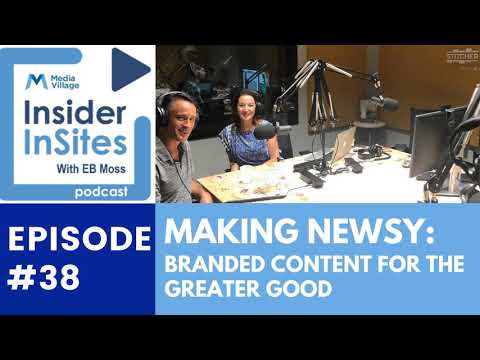Making Newsy: Branded Content for the Greater Good

I've got News(y) for you: There's a mainstream news service, which for a few years had been quietly focused on doing content a little differently and, in their minds, better. They planted a stake in the middle of the country to deliver "non-coastally skewed" stories via linear TV (near 40 million cable homes), digital (OTT to YouTube) and mobile to reach as wide a swath of demos as possible. Now, they're also walking the sustainability walk with a content studio dedicated to helping spread the stories of socially responsible brands. This has not only been upping advertisers' appreciation of Newsy, but also consumers' brand love for those advertisers.
Newsy, which was acquired a few years ago by E.W. Scripps — longtime parent to traditional news vehicles and, more recently, of innovative podcast division Stitcher — is aiming to offer both news and newsworthy ways to spotlight brands that are doing well by doing good. The one-off profiles and short-form docu-series by Andy Brownell, vice president of Newsy Brand Studio, and producer Joey Maiocco are not hard-driving headline stories, but are, nonetheless, of great importance to attracting and retaining more and more influential consumers. As Brownell described it, "We're focused on developing sponsored stories for brands looking to tell more about the key social issues that they're addressing, [such as] improving the environment."
In Episode 38 of our podcast Insider InSites, Brownell discusses the genesis of the studio and how it's helping Newsy triple its bottom line.
The following is an edited topline. Get the full scoop on Newsy's approach to "content marketing for good" by listening to the conversation in its entirety. Insider InSites is available wherever you subscribe to and download podcasts: Stitcher, Spotify, iHeartRadio, GooglePodcasts, Apple, and TuneIn.
E.B. Moss: Why use storytelling to showcase the impact brands can have on their industry or community?
Andy Brownell: I think there's a much greater awareness of what brands are doing in the world today. Today's consumers are much more tuned in to the kinds of things that brands are doing beyond just offering a product or service. Consumers are starting to make purchase decisions beyond the normal parameters ... whether it's a manufacturing company and the footprint it leaves ... to the role that companies play within their communities.
Moss: How do you keep it genuine, and ispurpose-driven Newsy branded content skewed towards a younger audience?
Brownell: Because we're a branded content studio that's connected to a national news organization, I think, by definition, we're held to a slightly higher standard in terms of the authenticity ... for the content to be genuine, to be able to inform people and provide them something of value. There are all these amazing stories and things that [brands] are doing that never make it into an advertisement, barely make it into the social feeds, and that [requires] a lot more time to tell a good, compelling story. That's what we really wanted to focus in on.
A good way to think about it is to look at the 17 sustainable development goals the United Nations has set out, [including] equality, poverty, climate, ocean health. Every one of those topics and more tie back to the kinds of things that you see brands getting more heavily involved in. And being in a news environment allows us to take that narrative, produce it in an authentic, compelling way ... [with a] national news platform to distribute it out across both Millennials, who are watching a lot of their content on OTT and connected TV devices, and older audiences who are still watching cable. Those stories resonate with all audiences.
My business partner, Joey Maiocco, and I had to figure out what we wanted to stand for and how that would fit within the news environment in a way that we felt good about, but more importantly, would tap into something that brands saw as a viable path and ethos. So, until we had new advertisers come in, we started to film a project on the national organization called the 2030 Districts, which has about 22 different cities focused on a 50 percent reduction in water, energy, and transportation-related greenhouse gases by the year 2030. We wanted to start a sustainability district on behalf of the city of Cincinnati and documented the process of ... ultimately, joining up and becoming members ... capturing everything on camera, including Mayor Cranley signing on.
[Like any brand], whether it's the editorial team or the brand studio, this is the community that we live and work in. And we wanted to see how we could help improve something and track that process along the way.
Moss: You created theShifting Baselinesseries as part of this and interviewed KoAnn Skrzyniarz, whom we also featured on anInsider InSites episodeand who founded Sustainable Brands, a global organization bringing brands and nonprofit organizations together to solve problems.
Brownell: Yes, we were a media partner for their June conference in Detroit. A huge portion of Fortune 500 companies have a presence there, and not just sustainability people, but chief marketing officers are there. Marc Pritchard [chief brand officer of P&G] talks a lot about that and "Brands For Good" — where sustainability has an equal seat at the table with brand managers.
Media and the role that we play at the brand studio can be an integral part of helping connect those dots and tell brand stories — such as [how P&G is] getting people to stop pre-rinsing their dishes because their Cascade product lets you can save a tremendous amount of water and energy. Or how Leesa Mattress, a B-Corp, direct-to-consumer mattress company, serves communities [by donating mattresses to] those relocated because of war or family violence. And that's an opportunity to tell that kind of story in a news environment where it matters, while giving people something that they can learn and benefit from.
Moss: Is pro-social content a hard sell?
Brownell: People are starting to make it a bigger part of the conversation and a bigger part of their marketing and communications plans. We've noticed over the last few years that a disconnect often takes place between the people making decisions on media that may be running on channels [such as] Newsy and the people who are running content programs, which come from a different agency. You have the PR and comms folks on the brand side who may not know that there are things like sponsored programs … that can tie into a media buy, that also give these stories a voice and bring some credibility. So, as we've been building the business, we're starting to see a lot more people talk about it. And I would expect that to continue to accelerate.
Moss: Given the silos that we're all trying to break down these days, are you seeing the ask come more from the agency side or more from the brand marketer side?
Brownell: It's really a mix. Brands [such as] Cleveland Clinic or IBM are very sophisticated content marketers. So, that's less of a hard sell. For some it's new and dipping that toe in the water takes a little bit of courage. But when you're able to kind of show the results and the impact that it can have, it becomes a much easier sell. When you're communicating something that drives back to purpose, there is a tangible thing that happens in our bodies, in our brains, and how we respond to that — something that I think every brand can learn from and, frankly, tap into.
Click the social buttons above or below to share this story with your friends and colleagues.
The opinions and points of view expressed in this content are exclusively the views of the author and/or subject(s) and do not necessarily represent the views of MediaVillage.com/MyersBizNet, Inc. management or associated writers.


